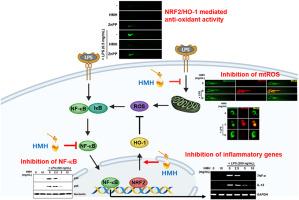Hovenia dulcis Thunb. monofloral honey attenuates LPS-induced inflammation and endotoxemia through the activation of the Nrf2/HO-1 axis
IF 3
3区 医学
Q1 INTEGRATIVE & COMPLEMENTARY MEDICINE
Journal of Traditional and Complementary Medicine
Pub Date : 2025-10-01
DOI:10.1016/j.jtcme.2024.09.003
引用次数: 0
Abstract
Monofloral honey derived from Hovenia dulcis Thunb. (HMH) is known for its antimicrobial and antioxidant properties. However, its potential to alleviate the inflammatory response has not yet been explored. The aim of this study was to investigate the anti-inflammatory and anti-endotoxemic effects of HMH. The findings showed that HMH did not exhibit toxicity to RAW 264.7 macrophages at low concentrations and suppressed the production of proinflammatory mediators, such as nitric oxide and prostaglandin E2, as well as cytokines, including tumor necrosis factor-α and interleukin-12 in lipopolysaccharide (LPS)-stimulated RAW 264.7 macrophages, by inhibiting NF-κB activation. Additionally, HMH prevented mortality and abnormalities in LPS-microinjected zebrafish larvae along with the inhibition of proinflammatory genes. In addition, HMH was found to reduce mitochondrial membrane potential depolarization and mitochondrial reactive oxygen species production in both LPS-stimulated RAW 264.7 macrophages and zebrafish larvae. Furthermore, HMH induced the expression of nuclear factor erythroid 2-related factor 2 (Nrf2) and heme oxygenase-1 (HO-1) and promotes the nuclear translocation of Nrf2. The anti-inflammatory effects of HMH are mediated via the Nrf2-HO-1 axis, and an HO-1 inhibitor reverses HMH-induced responses. This study is the first to demonstrate the anti-inflammatory and anti-endotoxemic effects of HMH, highlighting its potential as a therapeutic.

霍维尼亚·杜尔西斯·图恩。单花蜂蜜通过激活Nrf2/HO-1轴来减轻lps诱导的炎症和内毒素血症
单花蜂蜜,产自蜂蜜。(HMH)以其抗菌和抗氧化特性而闻名。然而,其减轻炎症反应的潜力尚未被探索。本研究的目的是研究HMH的抗炎和抗内毒素作用。研究结果表明,HMH在低浓度下对RAW 264.7巨噬细胞无毒性,并通过抑制NF-κB活化,抑制脂多糖刺激的RAW 264.7巨噬细胞中促炎介质如一氧化氮和前列腺素E2的产生,以及细胞因子如肿瘤坏死因子-α和白细胞介素-12的产生。此外,HMH通过抑制促炎基因,防止lps微注射斑马鱼幼鱼的死亡和异常。此外,研究发现,在lps刺激的RAW 264.7巨噬细胞和斑马鱼幼虫中,HMH均能减少线粒体膜电位去极化和线粒体活性氧的产生。HMH诱导核因子红细胞2相关因子2 (Nrf2)和血红素加氧酶-1 (HO-1)的表达,促进Nrf2的核易位。HMH的抗炎作用是通过Nrf2-HO-1轴介导的,HO-1抑制剂可逆转HMH诱导的反应。这项研究首次证明了HMH的抗炎和抗内毒素作用,突出了其作为治疗药物的潜力。
本文章由计算机程序翻译,如有差异,请以英文原文为准。
求助全文
约1分钟内获得全文
求助全文
来源期刊

Journal of Traditional and Complementary Medicine
Medicine-Complementary and Alternative Medicine
CiteScore
9.30
自引率
6.70%
发文量
78
审稿时长
66 days
期刊介绍:
eJTCM is committed to publish research providing the biological and clinical grounds for using Traditional and Complementary Medical treatments as well as studies that demonstrate the pathophysiological and molecular/biochemical bases supporting the effectiveness of such treatments. Review articles are by invitation only.
eJTCM is receiving an increasing amount of submission, and we need to adopt more stringent criteria to select the articles that can be considered for peer review. Note that eJTCM is striving to increase the quality and medical relevance of the publications.
 求助内容:
求助内容: 应助结果提醒方式:
应助结果提醒方式:


